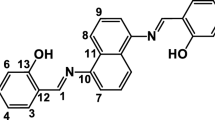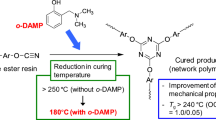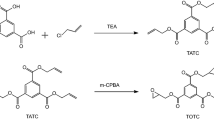Abstract
A trifunctional active ester curing agent, triacetoxytriphenylmethane (TATPM), which was dissolvable in diglycidyl ether of bisphenol A (DGEBA), was prepared and characterized. Though TATPM/DGEBA mixture was too viscous to flow at room temperature, its viscosity rapidly declined to a very low level when heating above 120 °C, showing great processability. Accelerators 4-dimethylaminopyridine (DMAP), 2-methylimidazole (2MI), and tetrabutylammonium bromide (TBAB) were used to catalyze the reactions between TATPM and DGEBA. DMAP-catalyzed one reached Tpeak and Tendset earlier, and showed higher conversion than 2MI and TBAB-catalyzed one, exhibiting superior accelerating effect. Ea and A of DMAP-catalyzed system were higher than that of 2MI-catalyzed system. Moreover, the properties of cured products depended on accelerator type, and DMAP-catalyzed one had the highest Tg, Td5%, and Td10%, lowest Df, EQUATION and saturated water uptake, making DMAP a better accelerator than 2MI and TBAB. Meanwhile, TATPM cured epoxies showed higher Td, lower Dk and Df than that of phenolic compound THTPM cured epoxies, despite of its lower Tg.















Similar content being viewed by others
Data availability
Data will be made available on request.
References
Lee M, Paria S, Mondal S, Lee GB, Shin B, Kim S, Park S, Nah C (2022) Amphiphilic block co-polymer and silica reinforced epoxy composite with excellent toughness and delamination resistance for durable electronic packaging application. Polymer 245:124679
Li X, Zhou Y, Bao Y, Wei W, Fei X, Li X, Liu X (2022) Bismaleimide/phenolic/epoxy ternary resin system for molding compounds in high-temperature electronic packaging applications. Ind Eng Chem Res 61:4191–4201
Hou J, Fang L, Huang G, Dai M, Liu F, Wang C, Li M, Zhang H, Sun J, Fang Q (2021) Low-dielectric polymers derived from biomass. ACS Appl Polym Mater 3:2835–2848
Fu F, Shen M, Wang D, Liu H, Shang S, Hu F, Song Z, Song J (2021) A rosin-based dielectric polymer with intrinsic low dielectric constant and comprehensively excellent properties. J Mater Chem C 9:13144–13156
Maier G (2001) Low dielectric constant polymers for microelectronics. Prog Polym Sci 26:3–65
Chen CH, Lin CM, Juang TY, Abu-Omar MM, Lin CH (2019) The reaction of activated esters with epoxides for self-curable, highly flexible, A2B2- and A3B3-type epoxy compounds. Polym Chem 10:3983–3995
Nakamura S, Saegusa Y, Yanagisawa H, Touse M, Shirai T, Nishikubo T (1991) Thermal analysis of epoxy curing using polyfunctional active esters as curing agents. Thermochim Acta 183:269–277
Ogura I (1999) In: Nalwa HS (ed) Handbook of low and high dielectric constant materials and their applications. Academic Press, San Diego
Nakamura S, Arima M (1995) Characterization of the network structure of epoxy resins cured with active esters. Int J Polym Anal Ch 1:75–86
Nishikubo T, Kameyama A (1993) Addition reactions of cyclic ethers with various carbonyl compounds and their application for polymer synthesis. Prog Polym Sci 18:963–995
Chen CH, Lee KW, Lin CH, Ho MJ, Hsu MF, Hsiang SJ, Huang NK, Juang TY (2018) High-Tg, low-dielectric epoxy thermosets derived from methacrylate-containing polyimides. Polymers (Basel) 10:27
Liu J, Liu X, Cui X, Qin J, Wu M, Fu L, Shi M, Wang D, Liang L (2023) Investigation on the properties and structures of resveratrol-derived epoxy thermosets cured with an active ester. Polym Chem 14:1665–1679
Cao Q, Li J, Qi Y, Zhang S, Wang J, Wei Z, Pang H, Jian X, Weng Z (2022) Engineering double load-sharing network in thermosetting: much more than just toughening. Macromolecules 55:9502–9512
Funahashi K (1978) New ring opening reactions of three membered heterocycles, oxiranes, aziridines, and thiiranes, with phenyl acetate. Chem Lett 7:1043–1044
Funahashi K (1979) New preparation of polyethers with pendant ester groups and a poly(ether-carbonate). Die Makromol Chem 180:501–503
Funahashi K (1979) New ring opening reactions of oxiranes with aryl carboxylates. B Chem Soc Jpn 52:1488–1492
Nishikubo T, Iizawa T, Takahashi E, Nono F (1985) Study of photopolymers. 26. Novel synthesis of self-sensitized photosensitive polymers by addition reactions of poly(glycidyl methacrylate) with nitroaryl cinnamate. Macromolecules 18:2131–2135
Nishikubo T, Iizawa T, Saita S (1986) Addition reactions of pendant epoxide group in poly(glycidyl methacrylate) with various active esters. J Polym Sci Pol Chem 24:1685–1695
Nishikubo T, Shimokawa T (1986) A novel insertion reaction of epoxy compounds into the pendant ester linkage of poly[4-(4-nitrobenzoyloxy)styrene]. Die Makromol Chem, Rapid Commun 7:179–181
Nishikubo T, Saita S, Fujii T (1987) New thermo-crosslinking reactions of polymers containing pendant epoxide groups with various polyfunctional active esters. J Polym Sci Pol Chem 25:1339–1351
Nishikubo T, Tanaka K (1987) A novel reaction of epoxy resins with polyfunctional active esters. J Appl Polym Sci 33:2821–2831
Nishikubo T, Saita S (1987) New thermo-crosslinking reactions of copolymers of phenyl methacrylates by use of polyfunctional epoxy compounds. Die Makromol Chem 188:799–809
Nishikubo T, Shiina A, Isobe N (1988) New addition reaction of active ester or cyclic ester with epoxy compounds catalyzed by insoluble polystyrene-bound quaternary phosphonium or ammonium salts. Chem Lett 17:1605–1608
Nishikubo T, Shimokawa T, Hirano T, Shiina A (1989) A novel insertion reaction of epoxy compounds into phenyl ester linkages in polymer chains. J Polym Sci Pol Chem 27:2519–2530
Nishikubo T, Kameyama A, Maejima C, Yamamoto Y (1994) Soluble polymer-supported catalysts containing pendant quaternary onium salt residues for regioselective addition reaction of epoxy compound with active ester. Macromolecules 27:7240–7247
Nishikubo T, Kameyama A, Kudo H (2003) Novel high performance materials. Calixarene derivatives containing protective groups and polymerizable groups for photolithography, and calixarene derivatives containing active ester groups for thermal curing of epoxy resins. Polym J 35:213–229
Nakamura S, Arima M (1993) Network structure and glass transition of epoxy resins cured with active ester. J Therm Anal 40:613–619
Chen CH, Gu ZC, Tsai YL, Jeng RJ, Lin CH (2018) Identification of the reaction mechanism between phenyl methacrylate and epoxy and its application in preparing low-dielectric epoxy thermosets with flexibility. Polymer 140:225–232
Chen CH, Liu CH, Ariraman M, Lin CH, Juang TY (2018) Phosphinated poly(aryl ether)s with acetic/phenyl methacrylic/vinylbenzyl ether moieties for high-Tg and low-dielectric thermosets. ACS Omega 3:6031–6038
Lin CM, Chen CH, Lin CH, Su WC, Juang TY (2018) Using dicyclopentadiene- derived polyarylates as epoxy curing agents to achieve high Tg and low dielectric epoxy thermosets. ACS Omega 3:4295–4305
Meng H, Zhang Q, Lu M, Qu Z, Chen B, Xu C, Lu M (2021) Cure kinetics and properties of high-performance epoxy thermosets cured with active ester-terminated poly (aryl ether ketone). High Perform Polym 33:1047–1060
Heise MS, Martin GC (1989) Curing mechanism and thermal properties of epoxy-imidazole systems. Macromolecules 22:99–104
Dell’Erba IE, Williams RJJ (2006) Homopolymerization of epoxy monomers initiated by 4-(dimethylamino)pyridine. Polym Eng Sci 46:351–359
Vyazovkin S, Burnham AK, Criado JM, Pérez-Maqueda LA, Popescu C, Sbirrazzuoli N (2011) ICTAC Kinetics Committee recommendations for performing kinetic computations on thermal analysis data. Thermochim Acta 520:1–19
Vyazovkin S, Sbirrazzuoli N (2006) Isoconversional kinetic analysis of thermally stimulated processes in polymers. Macromol Rapid Comm 27:1515–1532
Starink MJ (2003) The determination of activation energy from linear heating rate experiments: a comparison of the accuracy of isoconversion methods. Thermochim Acta 404:163–176
Criado JM, Perez-Maqueda LA, Gotor FJ, Malek J, Koga N (2003) A unified theory for the kinetic analysis of solid state reactions under any thermal pathway. J Therm Anal Calorim 72:901–906
Luo XW, Ping ZH, Ding JP, Ding YD, Li SJ (1997) Mechanism studies on water sorption and permeation in epoxy resin by impedance spectroscopy. II. Cure kinetics of o-cresol novolac resin with esterfied phenol novolac resin. J Macromol Sci A 34:2279–2291
Zhang P, Ali Shah SA, Gao F, Sun H, Cui Z, Cheng J, Zhang J (2019) Latent curing epoxy systems with reduced curing temperature and improved stability. Thermochim Acta 676:130–138
Li J, Ren C, An D, Ren Y, Moon K, Wong C (2020) Systematic evaluation of cyanate ester/epoxidized cresol novolac copolymer resin system for high temperature power electronic packaging applications. Polymer 195:122454
Liu Z, Huo J, Yu Y (2017) Water absorption behavior and thermal-mechanical properties of epoxy resins cured with cardanol-based novolac resins and their esterified ramifications. Mater Today Commun 10:80–94
Acknowledgements
This work was financially supported by National Key Research and Development Program of China (Grant # 2020YFE0100300).
Funding
National Key Research and Development Program of China, 2020YFE0100300, Longhai Guo.
Author information
Authors and Affiliations
Corresponding author
Ethics declarations
Conflicts of interest
The authors declare that there is no conflict of interest.
Additional information
Publisher's Note
Springer Nature remains neutral with regard to jurisdictional claims in published maps and institutional affiliations.
Rights and permissions
Springer Nature or its licensor (e.g. a society or other partner) holds exclusive rights to this article under a publishing agreement with the author(s) or other rightsholder(s); author self-archiving of the accepted manuscript version of this article is solely governed by the terms of such publishing agreement and applicable law.
About this article
Cite this article
Xing, A., Gao, C., Yuan, P. et al. A trifunctional active ester for curing DGEBA: synthesis, curing behavior, and properties of its cured product. J Polym Res 31, 66 (2024). https://doi.org/10.1007/s10965-024-03899-4
Received:
Accepted:
Published:
DOI: https://doi.org/10.1007/s10965-024-03899-4




